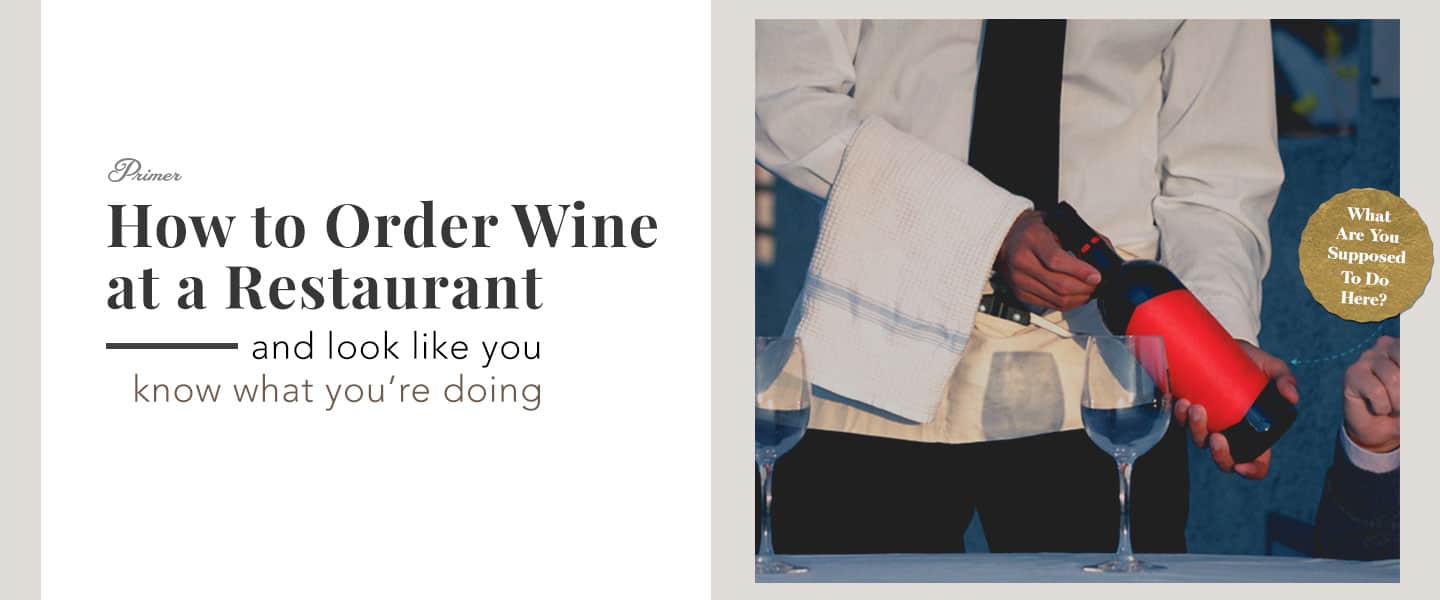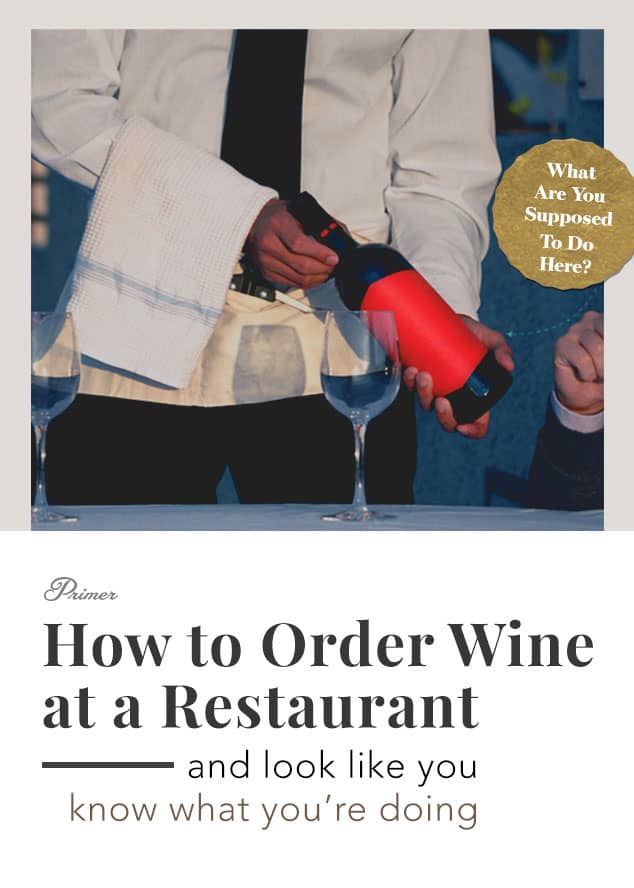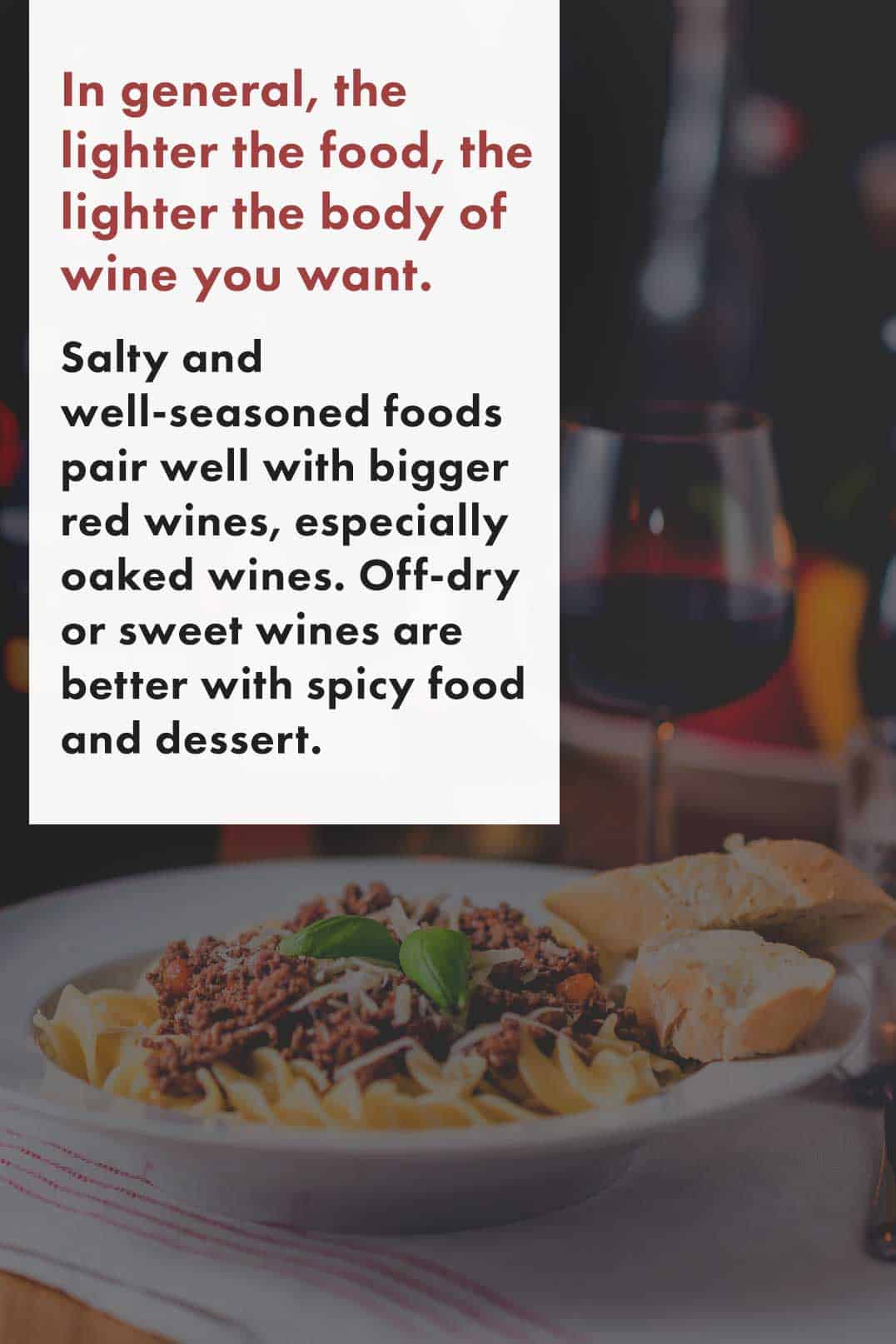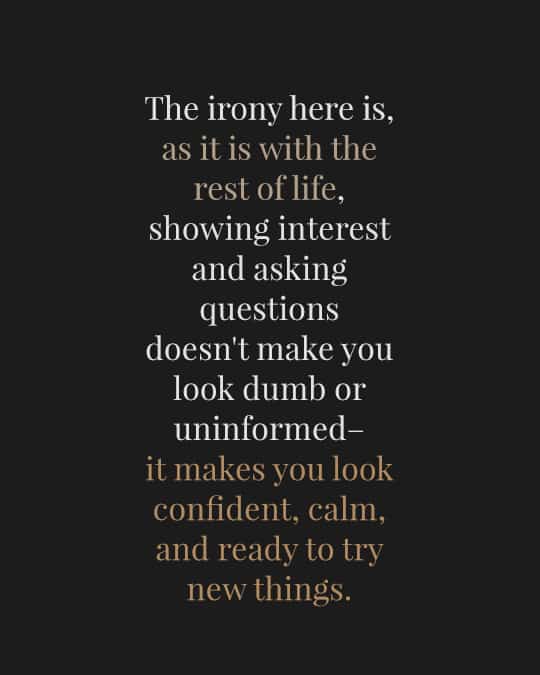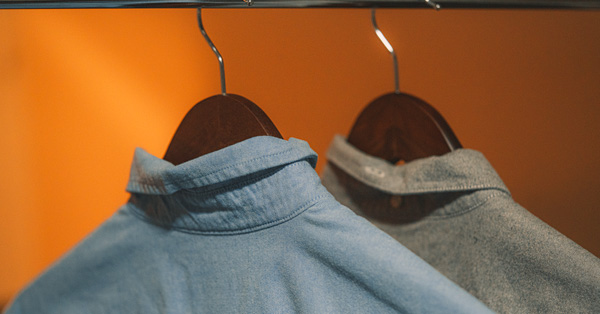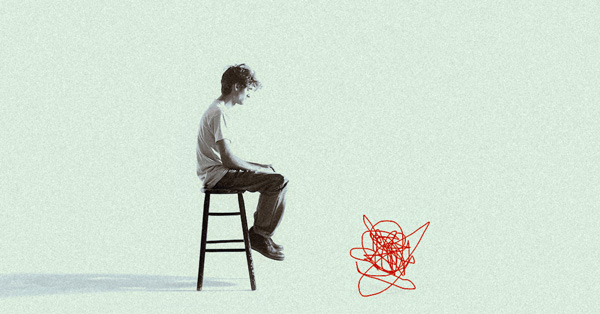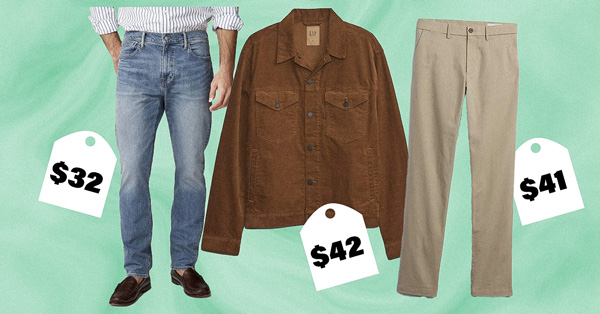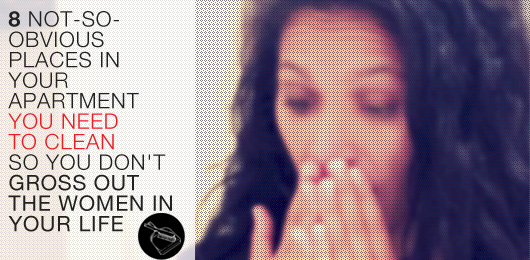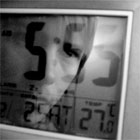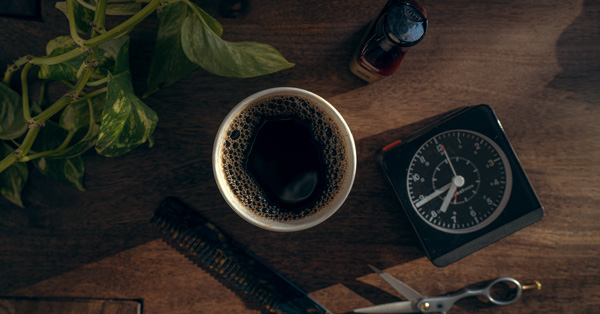Did you know that, as a group, Millennials are now the single largest consumers of wine in the US? Brush up on your grownup grape juice with our Easy Explanation of Different Wine Types
Unless you've completed the thousands of hours of work, study, and tasting required to become a Master Sommelier it can be pretty intimidating to know how to order wine at a restaurant. Ordering wine at dinner is often a first indication of one's knowledge, confidence, and sense of culture.
What makes it even harder is feeling like you're expected to know what you're doing – especially if you're ordering wine on a date.
If you're ordering a bottle at a restaurant there's the added pressure of the investment you're about to make. Restaurant wine ain't cheap for a reason – it's often how nicer establishments make the majority of their revenue!
Fortunately, there’s no need to worry. There’s a fairly standard procedure for picking wine at a restaurant — and you don’t have to be a wine snob for it to work. If you want to both impress and augment the enjoyment of your dinner, simply complete the following objectives:
1. Do Your Homework
Goal: Get the lay of the land and find out what expert help is available.
Take away the pressure of being put on the spot by finding out as much as you can beforehand. Make your reservation during an off-peak hour so the host or hostess has time to answer some questions about the wine list:
Do you serve wine or is it BYOB?
There’s nothing worse than showing up at a restaurant only to find out that they don’t have a liquor license. Sometimes, you can get a restaurant's wine list off of their website. If you make your selection beforehand from the online wine menu, be sure to mention it when you call. Ask if they can reserve the bottle for you when you call, since wine lists are often outdated and/or seasonal.
If it is BYOB, what is the corkage fee?
Going BYOB, (bring your own bottle), even if the restaurant does serve wine, can be more affordable and less stressful. You avoid the restaurant markup and you can choose a bottle at your leisure without everyone watching you. Just two things to keep in mind: expect to pay a corkage fee of $5 to $25 (ask when you call) and don’t bring a wine that they have on their wine list.
You could even get the best of both worlds by bringing an accessible red for the meal and ordering a glass of white for sipping as soon as you sit down.
Will there be a wine specialist available?
At some fancy restaurants, there will be a dedicated sommelier (sum-all-ee-ay)—the person who actually put together the wine list and knows it the best. This is ideally who you’d like to speak to.
Your next best scenario is talking to the proprietor. If they're not available, you might have to speak with your server. It’s best to know this ahead of time. Otherwise, you’ll look pretty goofy asking to speak to the sommelier if there isn’t one.
Later in the process (Step 3) you're going to engage whomever is available to help, and this is a good thing. Just remember that they're there to help you buy wine.
But first, you need to be ready for this conversation with some parameters on wine type and price.
2. Apply Process of Elimination to the Wine List
Goal: Establish your price range and narrow down your top choices.
A good wine list will include the price, the producer, the grape variety and/or region and the vintage for each wine. There may also be an item number on the wine list. You can refer to this if you can’t pronounce the name of the wine.
Wines labeled NV are nonvintage meaning they are a blend of different wines, and thus can’t have a vintage. Wine snobs will turn their noses up at nonvintage wine, but don’t rule them out. Wine producers make non-vintages for the sake of consistency, meaning that they can often be safer bets than a vintage wine that was made during a climactically shaky year.
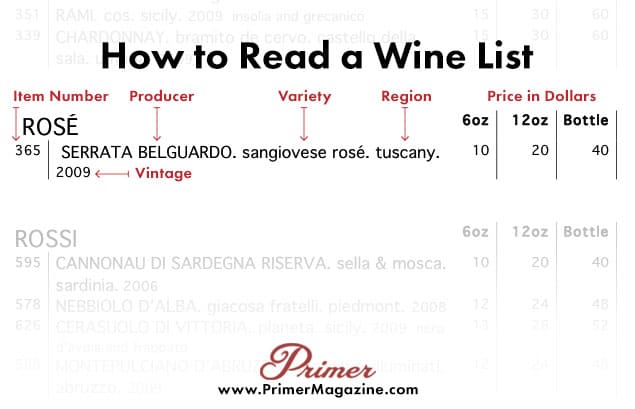
Wine lists are some of the most arcane, inconsistent and sometimes misleading documents on the planet. Be cool. You’re not a contestant on The Price is Right. There are very few “wrong” choices here, and as long as you ask and answer the right questions, you’ll be steered well clear of them.
Survey the list and narrow down your options to two or three bottles of wine. You’ll present these to the server or the wine specialist before making the final decision. But for now, let’s focus on nominating your top candidates. Here’s what you need to decide:
Red or white?
Answering this question will eliminate half the wines on the list. Simply ask your companions what they like. If they don't have a preference, ask what they plan on ordering for dinner and follow these guidelines:
- Drink white wine with light fish dishes (cod, tilapia, etc.) and shellfish, go with a light-bodied white wine. Safe bets: Pinot Grigio, Sancerre or Sauvignon Blanc (California, South Africa, New Zealand).
- Drink red wine for light meat and poultry dishes, salmon, meaty dishes, and heavy tomato sauces. Safe choices: California Red Zinfandel, California Pinot Noir, Bourgogne Rouge, Barbera, Dolcetto.
- Drink white wine or sparkling wine with spicy foods and pastas with a vegetable or cream sauce.
These, of course, are guidelines, not hard and fast rules. Don’t focus too much on the type of meat, since the sauce and preparation matter far more. In general, the lighter the food, the lighter the body of wine you want. Salty and well-seasoned foods pair well with bigger red wines, especially oaked wines. Off-dry or sweet wines are better with spicy food and dessert.
Next, you need to figure out:
How much should I spend?
Your first instinct may be to choose a wine based on price. Resist it. This has nothing to do with coming off as a cheapskate, since many modestly priced wines are indeed quite good. Likewise, a bottle of wine won’t go well with your meal simply by virtue of being the most expensive on the list.add
There’s really no formula for determining how much to spend on wine—just spend what you feel comfortable with. Part of the reason why you’re choosing two or three choices is to communicate to your server what your price range is. Even if they don’t recommend one of the wines you choose, they’ll know what you’re willing to spend.
On the other hand, if you are trying to impress by being a big spender, don’t get the most expensive bottle on the standard wine list. Ask for the reserve wine list. But you had better know what you’re doing if you pull this one!
How adventurous am I feeling?
There are two main approaches to ordering wine. You can look for a wine that is familiar and accessible, i.e. a safe bet. If this is what you’re in for, just look for a wine you’ve had before and order it, or, ask for a similar wine that will pair well with your food.
Or, you can be more adventurous and order something completely foreign to you. To pull this off, you shouldn’t act like you know what you’re doing. Instead, embrace your ignorance and seek enlightenment.
Find something that piques your interest, either because you recognize the wine type or it just has a funny sounding name. Be forthcoming with your server about your willingness to learn more and experience something new. “I’ve never heard of Frappato. What can you tell me about it?” The irony here is, as it is with the rest of life, showing interest and asking questions doesn't make you look dumb or uninformed – it makes you look confident, calm, and ready to try new things.
3. Seek Expert Advice from the Wine Specialist
Goal: Leverage the expertise of someone who knows the wine list.
Now that you have your short list, it's time to call in the expert help that will help you make the final call.
To start, ask your server if there’s a wine specialist available. If you’ve done your homework, you already know the answer to this question. If there isn’t someone on hand, then you can ask your server for recommendations.
Show your server the three or four choices you were considering and ask them which they would recommend for your meal. If none of your shortlist are a good match for your entree, then at least your specialist knows what your price range is.
The sommelier or server will likely have some follow up questions for you. Before calling the server over, it can be useful to find out what your dinner companion likes and does not like. Feed this information to the server or sommelier up front. For example, tell them you want a light-bodied white wine that’s not too sweet, or tell them that you hate Chardonnay, etc.
Again, it’s important to adopt the role of an eager student. This isn’t like asking for directions at a gas station. You’re seizing an opportunity to become more educated about wine from one of the best sources available. This is how you become a wine connoisseur—by learning.
4. Survive the Wine Presentation
Goal: Determine if the bottle of wine has gone bad.
Once you order your bottle of wine, the server will initiate the ritualistic wine presentation. This is the part that makes most of us feel like Adam Sandler when he gets bumped up to first class in The Wedding Singer. Why is he showing me the bottle? What am I supposed to do with this cork? Hey, wise guy, I’m a big kid, I can handle a full glass.
Just about everything that happens during the wine presentation feels esoteric. But it’s really very simple.
The purpose of this is to determine whether the bottle of wine has gone bad, due to improper storage or a damaged cork. This isn’t Baskin Robbins, where you get to sample wine until you find one you like. Nor are you being asked to judge the quality and character of the wine. All you’re doing here is saying “yes” or “no” to the particular bottle of wine that the server is presenting to you.
What to do when a server shows you a bottle of wine:
- When the server shows you the unopened bottle, examine the label to make sure that it’s what you actually ordered. If so, say “okay,” and/or nod. If not, say so. It’s probably an honest mistake. Between the noise from a crowded restaurant and you mangling the pronunciation of the wine, it’s not uncommon for the server to write down the wrong wine.
- The server will uncork the bottle and either hand you the cork or lay it on the table. Pick it up and examine it. It should be slightly wet on the end that was in the bottle. If it’s dry and crumbly all the way through, that’s a red flag. If it’s wet and shriveled all the way through, that’s a red flag. Either way, nothing’s a deal breaker yet—you still have to taste the wine. Set the cork down when you’re done looking at it. You don’t have to sniff it. And definitely do not taste it.
- The server will pour a tiny bit into your glass. Stick your nose in the glass and take a big whiff. If you smell fruity aromas and other pleasant odors, that’s a good sign. If it smells vinegary, moldy or musty, that’s a bad sign.
- Taste it. Do this regardless if it smells bad. Just take a tiny sip and swallow. Don’t spit. If it tastes corky, musty, vinegary or just plain bad, then say so. Ask the server or your companions if they want to taste it and see if they agree that it’s bad. If they do, then you can ask them to take it back. They’ll oblige without question.
- If it tastes good, just say: “It’s fine.” with a smile. Set the glass down. The server will pour a full glass for your date and then fill up your glass the rest of the way. Cheers!
That’s all there is to it. Getting a bad bottle of wine is rare, but it happens, so don’t feel guilty about sending it back.
Once you have a good bottle of wine in your hands, then you’re in the clear. You did it! After going through the ritual of ordering wine at a restaurant a few times, you’ll get a feel for the process and what you can learn. Soon, selecting a bottle of wine for dinner will be as second nature as ordering a steak.



